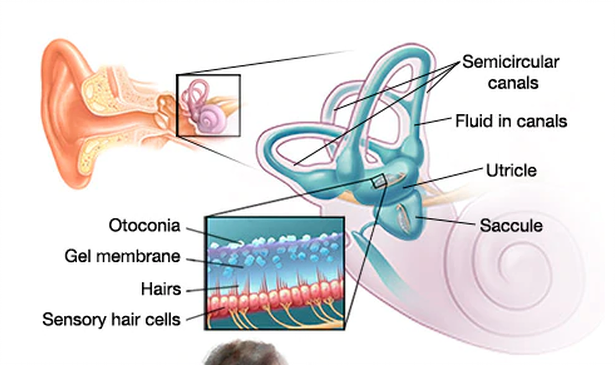Chances are, if you are reading this article you are one of the many people who have searched the internet looking up the different causes of dizziness. At Kinetic Edge Physical Therapy, we’ve put together the below information to help our clients throughout the Des Moines area understand the systems involved with balance, how our balance system works, common balance problems, and how physical therapy can help.
Systems Involved with Balance
Our brain is constantly receiving and analyzing information from our body systems to help maintain our balance. Here is a brief overview of the three main systems involved. Somatosensory is the information from joints and body positioning and makes up 70%. Vestibular is the information from fluid movement in the inner ear and makes up 20%. Vision is the final 10% of our balance.
How Does the Vestibular System Work?
There are three semicircular canals of the inner ear that use fluid movement to relay information to the brain (see figure 1). The hair follicles, in a stair step pattern, sense the fluid direction changes to relay head positioning to the brain. Each side of the brain is receiving signals from the ear that should correspond with the opposite side.
Figure 1. Photo: Mayo Education and Research
The problem
Otoconia (see figure 1) or sometimes referred to as “crystals” can become dislodged and alter fluid movement creating mixed signals. These mixed signals confuse the brain, which can cause dizziness. These mixed signals confuse the brain, which can cause dizziness or the sensation that your physical surroundings are spinning. This issue is also known as “Benign Paroxysmal Positional Vertigo,” “BPPV,” or “vertigo” for short. While BPPV is benign and symptoms may resolve on their own without further treatment, BPPV can vary in severity and duration based on the individual. For instance, some may experience relief from their symptoms in under a minute after changing positions or when making certain movements while others may experience more prolonged or severe symptoms. In addition to dizziness, symptoms of vertigo can include nausea, vomiting, or a loss of balance. These more troublesome symptoms can increase the risk of falling and make other daily tasks such as driving, reading, or looking at screens more difficult to perform until vertigo subsides.
The Fix is In!
While a sudden loss of balance and other symptoms associated with vertigo can be scary, have no fear, your physical therapist can help! Kinetic Edge Physical Therapy has helped clients throughout Des Moines, IA and the nearby communities manage and relieve their vertigo symptoms through physical therapy maneuvers so that they can get back to living their lives comfortably.
With clinic locations in Ames, Centerville, Colfax, Des Moines, Newton, Oskaloosa, Pella, or Waukee, when you visit Kinetic Edge Physical Therapy, a member of our staff will take the time to discuss your issue to recommend the right treatment to help with your balance issue. We’ll conduct a vestibular examination to determine which side of the body and ear canal is affected. From there, the repositioning maneuver of the otoconia or “crystals” takes just minutes and can resolve your vertigo symptoms in as little as one treatment.
If you have any questions about how to improve poor balance or would like to know more about how physical therapy can help with treating vertigo, do not hesitate to contact us today! We invite you to reach out to us online or by calling 866-588-0230.




